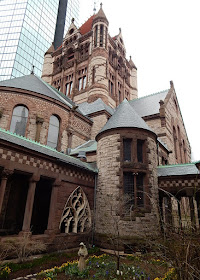H. H. Richardson’s design
for Trinity Church on Boston’s Copley Square firmly established him as the most
important architect in this country, and also made him the first to be
recognized and respected abroad. This
distinction was reinforced when his fellow architects selected Trinity Church
to head the list of the ten best buildings in the United States in 1885. A century later, it was the only building
from the original list to be included in a similar survey sponsored by the American
Institute of Architects. More recently,
Geoffrey Baer included the building in his PBS documentary “Ten Buildings That
Changed America.”
Richardson received the
commission through a competition in the spring of 1872, of which he was one of
six architects invited to submit. By the
time construction began on the building itself in 1874, Richardson had moved
his home and office to Brookline, so that he could closely supervise the
building. He would remain in Brookline
for the remainder of his life, resulting in the largest concentration of his
work being located in Boston and surrounding towns.
One of four piers supporting the tower
Work began in 1873 when 4,500
wooden piers were driven into the ground to support the enormous weight of the
building. Four huge piers in the sanctuary support the
weight of the tower, and sit upon granite pyramids underground, measuring forty
feet wide by twenty feet tall. This
massive engineering feat was essential, given that the site sat in the middle
of the Back Bay, a former swampy area that had been filled in over the
preceding fifteen years.
Parish House
The overall plan
of the building is in the shape of a Greek cross, with the Parish House
extending to the northeast, reflecting the original irregularly shaped plot of
land.
The exterior comprises four
different types of local granite and is trimmed with Longmeadow
brownstone. Richly carved ornament is
set amidst walls featuring Richardson’s trademark polychrome stone work,
including checkboard and zigzag patterns on the front façade, and eight-petaled
flowers on the apse.
Inspiration for the
overall design includes the French Romanesque which Richardson studied
extensively during his years at the Ecole des Beaux Arts in the early
1860s. His refinement of the style led
to what later became known as Richardsonian Romanesque and characterized the
buildings in the later years of his career.
The cathedral at Salamanca, Spain served as a model for the large
tower.
In 1876, at Richardson’s
request, the congregation hired John La Farge to complete the interior
decoration. As noted by Keith Morgan in
his Buildings of Boston, “(La Farge),
assisted by Augustus St. Gaudens and a team of American artists, produced the
most extensive scheme of figurative and architectural painted ornament of any
American building up to that time, influencing the emergency of mural
decoration in American public buildings.”
The interior features an
exceptionally open auditorium for Rev. Phillips Brooks, a Harvard classmate of
Richardson, considered one of the finest preachers of the late 19th
century. A marble bust by Daniel Chester
French dominates the baptistry, and was completed in 1897. It commemorates Brooks’ 22 years as rector of
Trinity Church, and his two years as Bishop of the Diocese of Massachusetts, in which position he served until his death in 1893.
Christ in Majesty (detail)
The church features a
dazzling collection of American and European stained glass windows. Five are by La Farge, including the Christ in
Majesty window set into three lancets over the main entrance, and his New Jerusalem
window in the north transept.
The New Jerusalem (detail)
That area features
a series of windows by Sir Edward Burne-Jones for Morris & Co., who also designed the window, David’s Charge to Solomon, located in the baptistry.
David's Charge to Solomon
William Morris as the head of Goliath (detail from upper right of window)
A humorous note is that Burne-Jones
incorporated Morris’ image in the window, as the severed head of Goliath being
held in the right hand of David. Other
English windows include a series of seven surrounding the chancel by Clayton
& Bell of London and several by Henry Holiday, also of London, including
Three Scenes in St. Paul’s Life, shown below.
Three Scenes in St. Paul's Life
The building was consecrated
in February 1877 with the total cost of the site and building at $635,000. In 1897, Richardson’s successors, Shepley,
Rutan and Coolidge, added the richly carved west porch, combining Richardson’s
general scheme and the design of St. Trophime, a Romanesque church in
Arles, France. The firm returned to add
the massive sculptural pulpit in 1914.
Architects Maginnis and Walsh extensively remodeled the apse in
1937-1938 to reflect the shift toward a more ceremonial form of worship.
2015
2017
A major restoration and
expansion was begun in 2003, and continues to this day, with significant work
on the exterior being undertaken during 2017.
















No comments:
Post a Comment